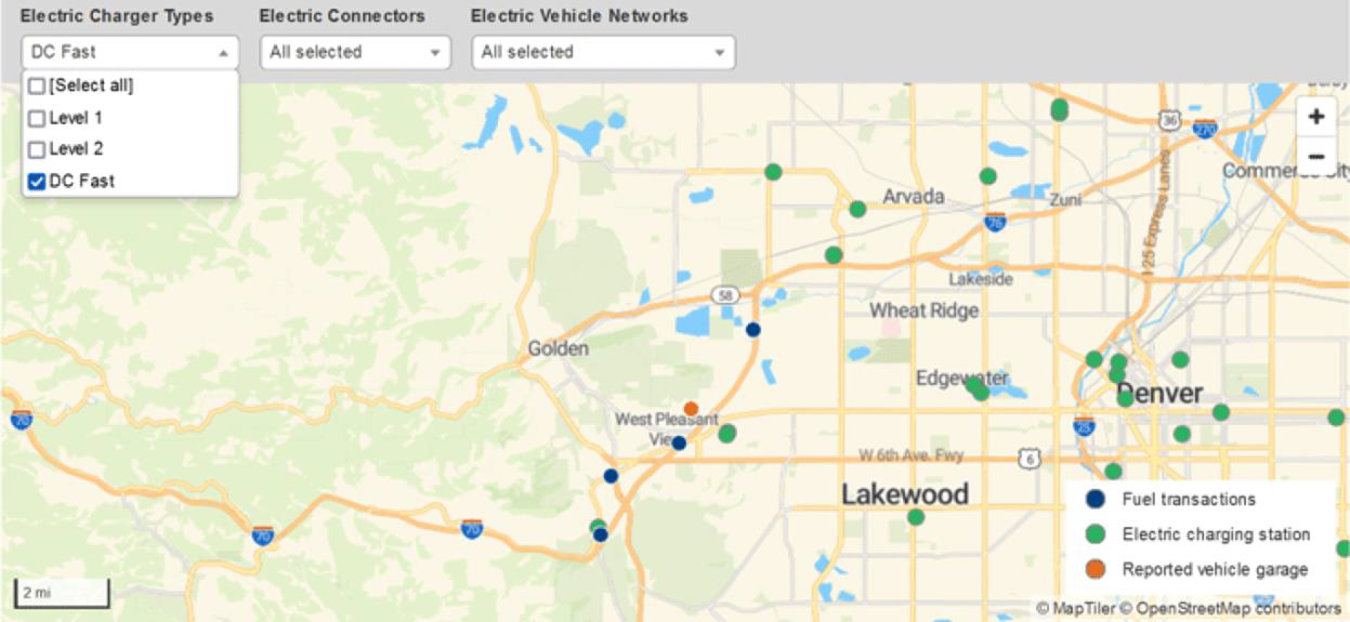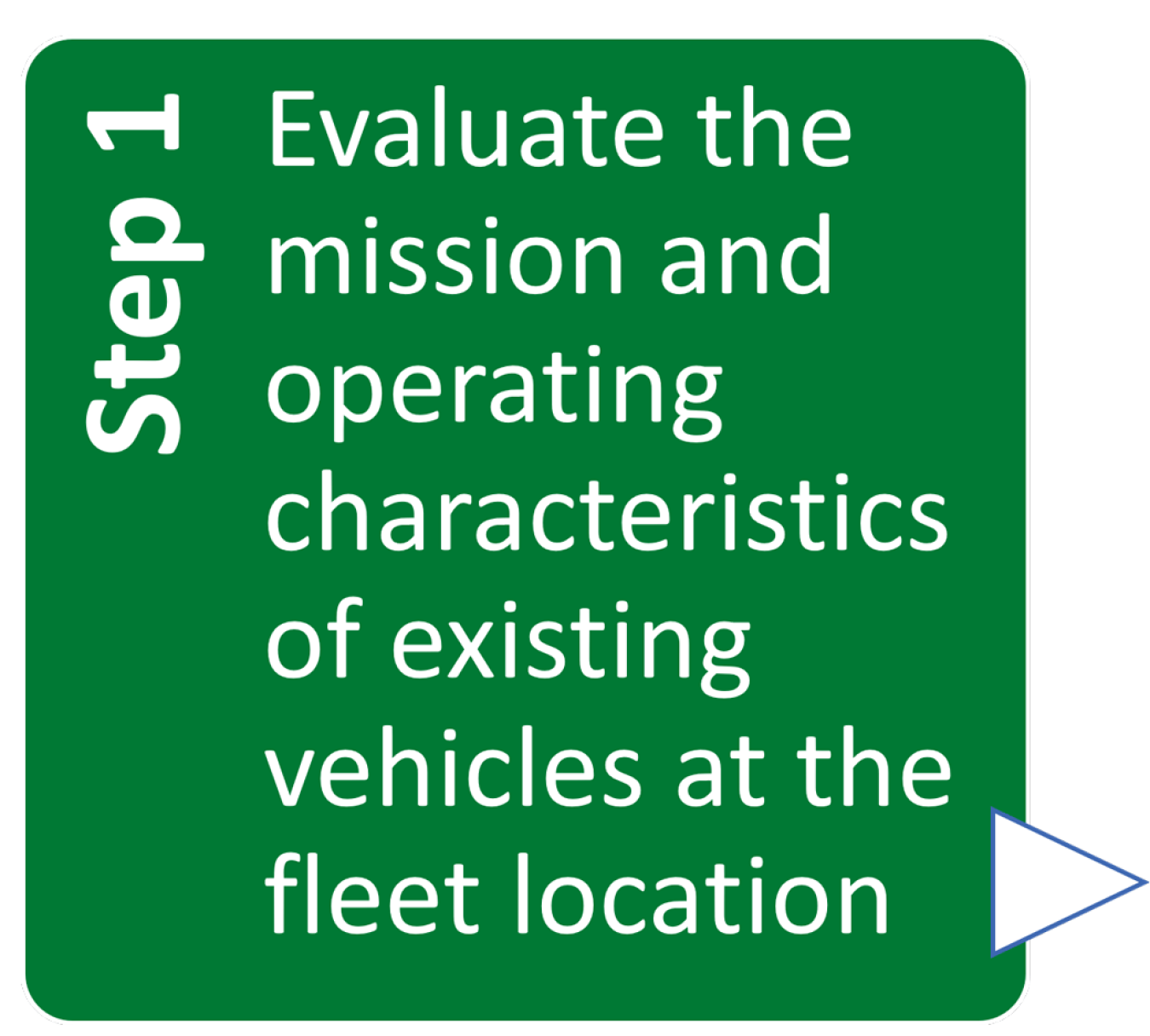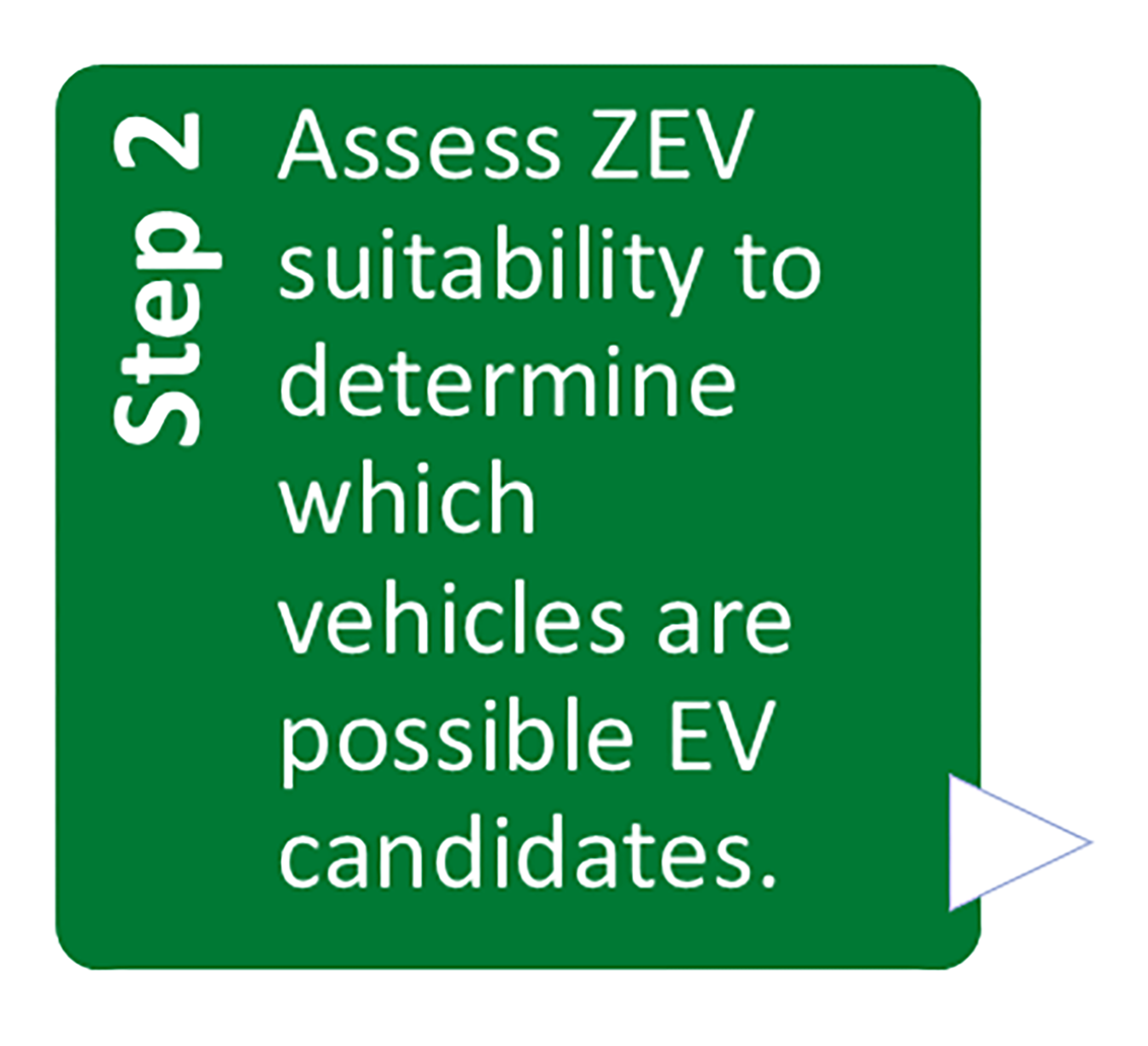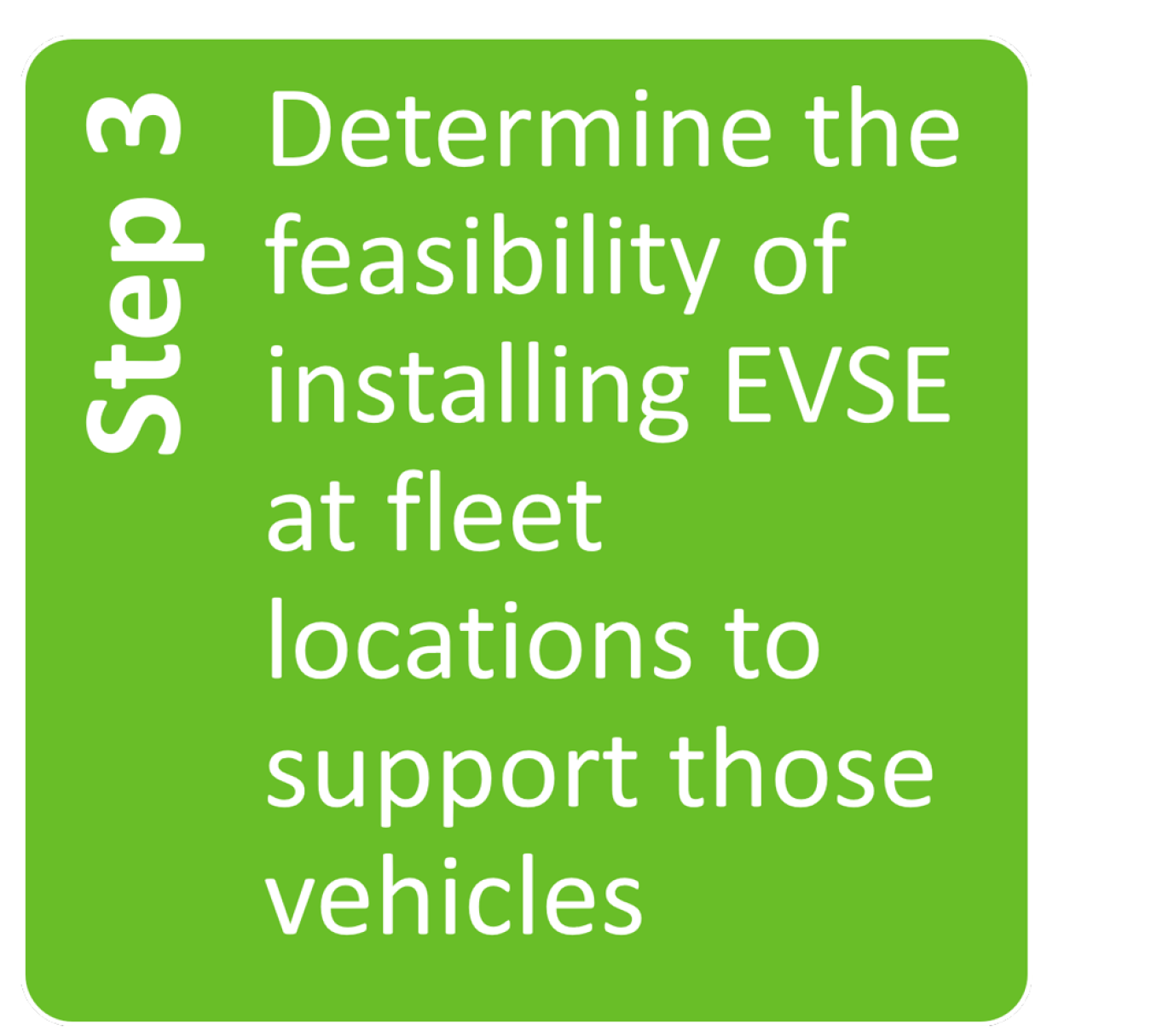Step 5 of the site-level federal fleet ZEV Ready process includes identifying zero-emission vehicle (ZEV) opportunities.
Navigate the ZEV Ready Process
| Planning Phase Steps |
|---|
| 1. Identify and coordinate team |
| 2. Review training materials |
| 3. Review requirements and data |
| 4. Align headquarters strategy with site planning |
| 5. Identify ZEV opportunities (5 years) |
| 6. Identify EVSE opportunities (5 years) |
| 7. Coordinate site financial planning with headquarters |
Return to the ZEV Ready Center to see all 15 steps.
Primary Audiences
 | Agency Headquarters Fleet Managers |
 | Site ZEV Champions |
 | Site Location Fleet Managers |
The agency headquarters fleet managers, site ZEV champion, and site location fleet managers are the primary audiences responsible for identifying ZEV opportunities for the entire fleet at the facility or fleet location and the electric vehicle supply equipment (EVSE) required to support those vehicles (discussed in Step 6: Identify EVSE Opportunities). These primary audiences are supported by other key fleet stakeholders, as necessary.
Process To Assess the ZEV Suitability of Each Location
This planning stage involves identifying the specific opportunities (over a 5-year time horizon) to transition vehicles at each fleet location to ZEVs and determine the EVSE needed to support those ZEV opportunities.
The agency headquarters fleet managers coordinate with site location fleet manager(s) and the site ZEV champion to identify opportunities to acquire ZEVs and deploy EVSE to support those vehicles at each fleet location. The process detailed in this section summarizes how agencies can assess the ZEV suitability of each vehicle at each fleet location. This process includes three steps:
Step 1—Evaluate the mission and operating characteristics of existing vehicles at the fleet location.
Step 2—Assess ZEV suitability to determine which vehicles are possible EV candidates.
Step 3—Determine the feasibility of installing EVSE at fleet locations to support those vehicles.
This section, ZEV Ready Step 5: Identify ZEV Opportunities, provides detail in evaluating and identifying suitable EV candidates at each fleet location, the first two steps of this process. The third and final step, determining the feasibility of installing EVSE to support those EV candidates, is discussed in Step 6: Identify EVSE Opportunities.
Fleet expertise and vehicle data should inform decisions on which vehicles to replace with ZEVs in future procurement cycles and the coordinated plan for deploying EVSE at fleet locations to support these vehicles. Agencies may use the optional ZEV Planning and Charging (ZPAC) tool (recommended and described below) or another method to help assess ZEV opportunities at each fleet location.
ZEV Planning and Charging Tool
The Federal Energy Management Program developed the ZPAC tool to assist agencies in planning for future ZEV acquisitions and deploying EVSE at each fleet location.
ZPAC is an optional tool that supports detailed analysis of the ZEV suitability for each existing vehicle in an agency’s inventory, using current estimates of future ZEV model availability, modeling of battery electric vehicle (BEV) range concerns, and the potential impact on greenhouse gas emissions. The tool allows agencies to assign a specific location to each vehicle and then uses the projected ZEV acquisitions at those locations to identify EVSE needs. Using the ZPAC tool also ensures that replacement options will serve the vehicle mission and charging requirements and do not cause undue burden on fleet operations. More detail on the ZPAC tool is provided in the sections below.
Using the ZPAC Tool
FEMP and NLR created the ZPAC tool to support and guide fleet managers in determining which individual vehicles should be replaced with ZEVs and the number of EVSE units required to support the ZEV fleet.

Agency headquarters fleet managers should begin evaluating fleet ZEV opportunities by assembling a baseline fleet profile. This involves constructing a database for each fleet vehicle that includes the vehicle characteristics (e.g., age, type, standard item number, fuel type), location, operations, and mission data elements necessary to evaluate ZEV suitability. This is prepopulated in the ZPAC tool based on fleet data in the Federal Automotive Statistical Tool and Fleet Sustainability Dashboard (FleetDASH). FleetDASH also contains an Alternative Fuel Vehicle (AFV) Screening Tool with most of the necessary data for General Services Administration (GSA)-leased vehicles.
The FleetDASH AFV Screening Tool shows a vehicle’s garage location, fuel transactions, and electric charging stations.
The site location fleet manager should evaluate the operating characteristics for each candidate vehicle, including average and maximum daily driving range, route, and drive cycle (data points of speed vs. time), to determine whether a BEV or plug-in hybrid electric vehicle (PHEV) can meet the vehicle mission needs. ZPAC uses an analytical model to estimate how frequently a BEV would need to charge publicly. While public charging is more time-consuming than gasoline fueling, public chargers are becoming ubiquitous and faster, even as most EV charging continues to take place on-site for fleet vehicles.
Assess ZEV Suitability To Identify Possible EV Candidates
The site location fleet manager, in coordination with the agency headquarters fleet managers, should next assess whether a BEV or PHEV is suitable for the vehicle’s operating mission. Some missions (e.g., unique upfitting requirements, law enforcement pursuit, extreme temperatures) may not be served by available BEVs and PHEVs.
After assessing and identifying potential EV candidates, the site location fleet manager, in coordination with the agency headquarters fleet managers, should next refine that list to:
- Match candidates with the availability of ZEVs from GSA or other sources
- Ensure that plans for acquisition of ZEVs are aligned with available fleet resources.
At least prior to FY 2024, the availability of ZEVs from manufacturers for the federal fleet may be limited due to either supply issues (e.g., battery availability or production limits) or demand issues (where consumer demand exceeds supply). If there are limits on available vehicles, fleet managers may have to eliminate some EV candidates or choose vehicles from similar vehicle classes.
In the ZPAC tool, agency headquarters fleet managers and site location fleet managers begin analysis in the “ZEV Selection” worksheet, which supports identification of ZEV candidates within agency fleets.
Becoming ZEV Ready

As part of the Vehicle Ready component of the ZEV Ready certification, the agency headquarters fleet managers, site location fleet managers, site ZEV champion, and identified key fleet stakeholders should work together to evaluate the potential for electrifying the entire fleet at their fleet location and identify ZEV opportunities (over the next 5 years) at the fleet location.
| PHASE | ZEV READY | STEP | ACTIONS |
|---|---|---|---|
| PLANNING |
| 5. Identify ZEV Opportunities (next 5 years) | ✔ The agency headquarters fleet managers, site location fleet manager, and identified key fleet stakeholders should identify ZEV opportunities for the entire fleet at the facility or fleet location for the next five vehicle replacement ordering cycles by using the ZPAC tool or similar planning tool like the FleetDASH AFV Screening Tool. This includes phasing vehicle deployments at the site for each fiscal year and comparing the deployments to goals in the agency’s Zero-Emission Fleet Strategic Plan:
For each fleet vehicle, identify potential replacements by ZEV type (BEVs, PHEVs, fuel cell EVs) and the ability of vehicles to meet mission requirements. ✔ The site location fleet manager/site ZEV champion should coordinate potential near-term ZEV replacement opportunities with the agency personnel responsible for placing vehicle orders (i.e., acquiring and procuring ZEVs). The site location fleet manager/site ZEV champion should also work with GSA (or an alternative vehicle supplier) to verify potential ZEV offerings, replacement, and acquisition cycles. |




